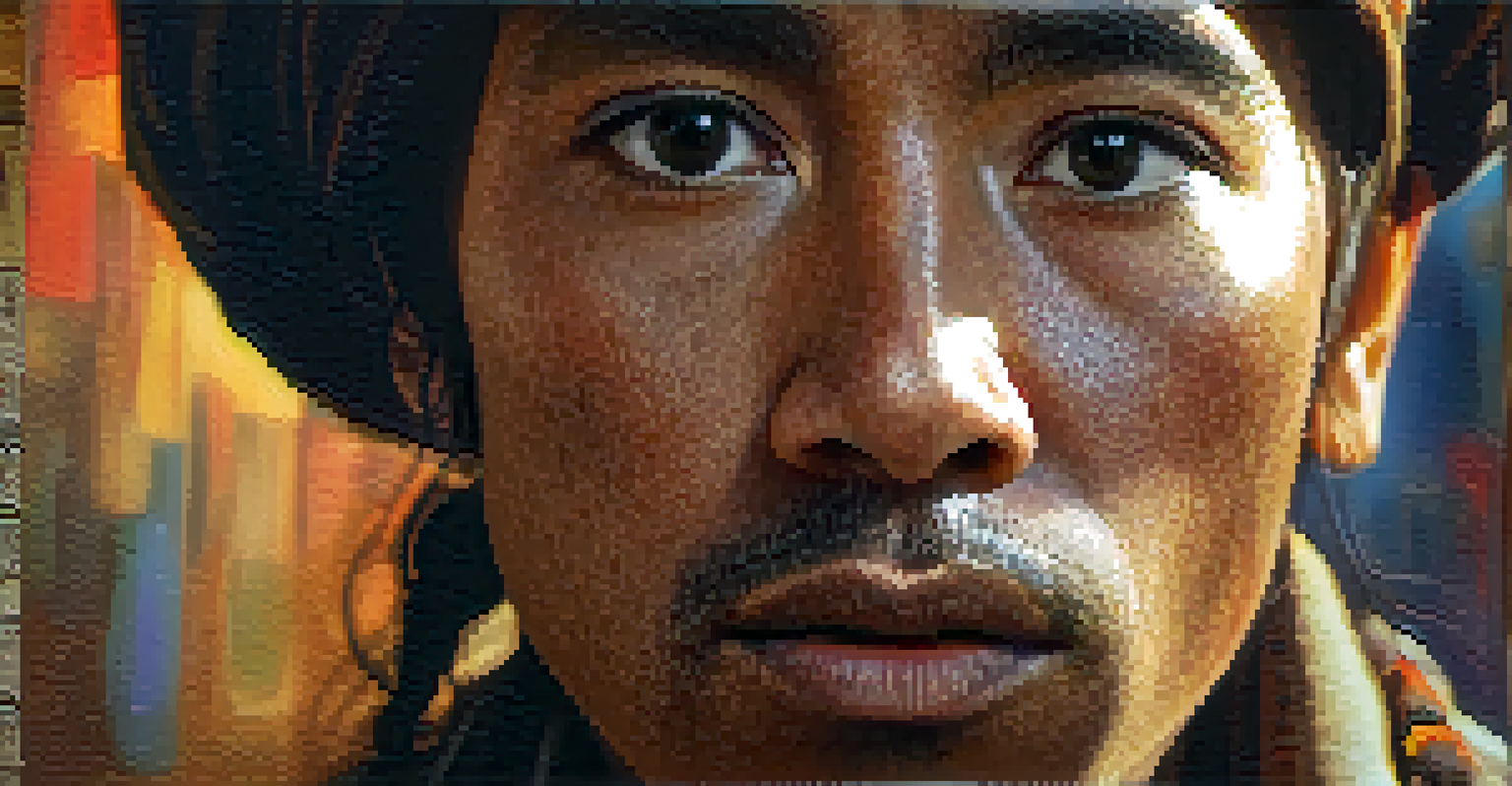Language and Representation: The Power of Multilingual Films

Understanding Multilingual Films and Their Impact
Multilingual films are cinematic works that incorporate dialogue in multiple languages. This approach not only reflects the diversity of global cultures but also enriches storytelling by presenting various perspectives. For audiences, these films can be a gateway to understanding different cultures, traditions, and social issues. The blend of languages creates a more authentic representation of characters and their environments, making the film experience more immersive.
Cinema is a mirror of society, reflecting the complexities of culture and identity.
Take, for instance, films like 'Roma' or 'Parasite,' which use their native languages to communicate deeper social messages. These films have gained international acclaim, showcasing how language can elevate a narrative beyond mere translation. By weaving different languages into the storyline, filmmakers provide a richer layer of meaning that resonates with both local and global audiences.
Moreover, multilingual films often challenge the viewer’s perceptions of language and identity. When characters switch languages, it symbolizes their cultural fluidity and adaptability. This dynamic encourages viewers to reconsider their understanding of language as a static concept, highlighting its role as a living, evolving form of expression.
Cultural Representation in Multilingual Storytelling
Cultural representation is crucial in film, and multilingual films often excel in depicting authentic narratives from diverse backgrounds. By using various languages, filmmakers can authentically portray the cultural nuances that define their characters. This authenticity not only resonates with audiences from those cultures but also educates others, fostering empathy and understanding.

For example, in films like 'Coco,' the use of Spanish alongside English allows for a genuine exploration of Mexican culture and traditions. This blend not only appeals to a bilingual audience but also introduces non-Spanish speakers to the richness of that culture. Such representation helps to dismantle stereotypes and provides a platform for underrepresented voices.
Multilingual Films Enhance Storytelling
By incorporating multiple languages, films like 'Roma' and 'Parasite' provide richer narratives that resonate with both local and global audiences.
Moreover, multilingual films often spark conversations about cultural heritage and identity. When characters navigate between languages, it mirrors the real-life experiences of many individuals in multicultural societies, showcasing the complexities of belonging and cultural pride.
The Role of Language in Character Development
Language serves as a powerful tool for character development in multilingual films. The choice of language can reveal a character's background, education, and emotional state, adding depth to their portrayal. A character who speaks multiple languages might embody adaptability and resilience, reflecting their journey through different cultures.
Language is the road map of a culture. It tells you where its people come from and where they are going.
For instance, in 'The Farewell,' the protagonist's struggle with English and Mandarin illustrates her internal conflict between her American upbringing and her Chinese heritage. This linguistic tension enriches her character arc, making her journey relatable to anyone who has experienced similar cultural divides. Language becomes a reflection of identity, shaping how characters interact with the world around them.
Additionally, the use of language can create barriers or bridges between characters, influencing their relationships. Moments of miscommunication or shared understanding can lead to significant turning points in the narrative, highlighting the importance of language in human connection.
Breaking Down Language Barriers in Film
Multilingual films also play a vital role in breaking down language barriers for audiences. Subtitles and dubbing allow viewers to engage with stories that might otherwise be inaccessible due to language differences. This accessibility opens up a world of storytelling, inviting audiences to experience diverse narratives from around the globe.
Films like 'Amélie' and 'Life Is Beautiful' have captivated audiences despite being in foreign languages, thanks to effective subtitle translations. These films demonstrate that storytelling transcends language, inviting viewers to connect with universal themes of love, loss, and hope. By bridging language gaps, filmmakers can share their unique cultural perspectives with a wider audience.
Cultural Representation Matters
Multilingual films authentically portray diverse cultures, fostering empathy and understanding while dismantling stereotypes.
Moreover, the success of multilingual films can encourage the production of more diverse content. As audiences embrace these films, studios may be inspired to create more projects that reflect the richness of global storytelling, further enhancing cultural exchange in cinema.
The Emotional Resonance of Language in Film
Language carries emotional weight, and multilingual films often tap into this power to enhance storytelling. The way characters express their feelings in their native tongue can evoke a deeper emotional response from the audience. Language becomes a vessel for conveying complex emotions, allowing viewers to feel the characters' joys and struggles more profoundly.
For example, the emotional impact of a character speaking in their mother tongue during a poignant scene can resonate with audiences on a personal level. This use of language can evoke nostalgia, longing, and even heartbreak, creating a shared emotional experience. It highlights how language is not just a means of communication but a crucial element of human connection.
Furthermore, the juxtaposition of different languages within a single film can create a rich tapestry of emotions. As characters switch languages, it reflects their emotional states, revealing vulnerability and strength. This dynamic adds layers to the narrative, drawing viewers into a more intimate understanding of the characters' journeys.
The Influence of Globalization on Multilingual Films
Globalization has significantly impacted the production and consumption of multilingual films. With audiences becoming more interconnected, there’s a growing demand for diverse storytelling that reflects the world’s cultural tapestry. Filmmakers are now more encouraged than ever to experiment with multilingual narratives that resonate with a global audience.
For instance, films like 'Crazy Rich Asians' and 'The Lunchbox' have achieved international success by blending cultures and languages. This trend not only highlights the appeal of multilingual films but also showcases the importance of representation in today’s globalized world. As more filmmakers embrace these narratives, the potential for cultural dialogue expands.
Language as a Character Tool
The choice of language in multilingual films reveals character depth and emotional complexity, enhancing the viewer's connection to the story.
Additionally, streaming platforms have played a crucial role in popularizing multilingual films. With easy access to international content, viewers are more willing to explore films from different cultures, further driving the demand for diverse storytelling. This shift signifies a new era in cinema, where multilingual films are celebrated for their artistic and cultural contributions.
Future of Multilingual Films and Cultural Dialogue
The future of multilingual films looks promising, with an increasing recognition of their role in fostering cultural dialogue. As audiences continue to seek authentic stories that reflect the complexities of the world, filmmakers are likely to explore even more diverse narratives. This trend will not only enrich the film landscape but also contribute to a more comprehensive understanding of different cultures.
Moreover, as technology continues to evolve, filmmakers have new tools at their disposal to enhance multilingual storytelling. Innovations in translation and subtitling can make it easier for audiences to engage with films in various languages, further breaking down barriers. This technological advancement can lead to a greater appreciation for the nuances of language and culture.

Ultimately, multilingual films hold the power to shape perceptions, challenge stereotypes, and foster empathy. By embracing the richness of language and representation, filmmakers can create impactful narratives that resonate globally, paving the way for a more inclusive future in cinema.